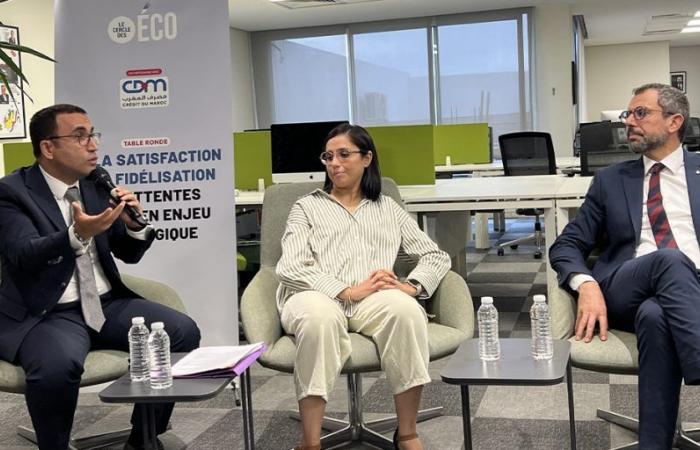The Cercle des Éco round tables inaugurated a new year on October 1, under the theme “From satisfaction to loyalty: customer expectations as a strategic issue”. The speakers were Saïd Jabrani and Larbi Chraibi from Crédit du Maroc, Souad Idrissi Kaitouni Galtier, from Marjane, and Saad Berrada from Intelcia. The evening was hosted by Meriem Allam, publishing director of Inspirations ECO.
For Intelcia’s general manager, Saad Berrada, the units monitoring the brand’s reputation in the digital world do essential work. The commitment of employees to the process is fundamental. A single HR problem can harm the company. Human relationships, internal or external, are, ultimately, the primary factor in customer satisfaction.
Customer satisfaction must therefore be strongly integrated into the corporate culture. While playing a little game with the audience present, Larbi Chraibi, director of the retail banking & marketing division of Crédit du Maroc, points out that “generally people do not have a brand to spontaneously cite when asked which ones are global, or local, references for customer satisfaction. A little time for reflection is necessary.
One of those that comes up often, then, is a world-renowned tech manufacturer. But, in the reasons for this perception, it is impossible to dissociate the part of satisfaction and that of excellent, very effective marketing, which he practices. The Moroccan market is still learning about this association. It is necessary to achieve excellence.
The challenge of competition
Saad Berrada points out that all companies now do benchmarking. It has become a reflex. The end consumer himself, today, does his benchmarking on the networks before buying. Consequently, differentiation is the key factor in customer loyalty. When a brand contacts one of them to tell them that, since they have not used the product to which they subscribed, it offers them the opportunity to choose this or that other service as a refund, it obviously builds the loyalty of this customer. The approach was unimaginable a few years ago.
“These brands have understood that it is not enough to sell once and abandon their customer, potentially dissatisfied,” explains Saad Berrada.
“Everyone has their own way, because it requires resources. Marjane and Crédit du Maroc (CDM) are fortunate to have good management, who observe the customer. But for smaller companies, the key is to find an axis with which to differentiate themselves in their ecosystem.
For his part, Souad Idrissi Kaitouni Galtier, deputy customer service director of Marjane, believes that the competition is very significant. The retail sector is very competitive: new operators are appearing, new formats, hypermarkets, etc. “The brand is therefore obliged to scrutinize the customer journey of its competitors. She compares the strengths and weaknesses with her marketing directions. Restitutions of image assessments make it possible to determine what the customer’s expectations are, beyond price or choice, such as practicality, comfort, customer service, fluidity at checkout…” It is impossible to construct courses or pretending to be the best without looking at what is happening with the competitors.
Saïd Jabrani, member of the management board in charge of commercial banking at Crédit du Maroc, recognizes that in his sector, we must also draw inspiration from best practices.
Levers to build lasting loyalty
“Studies show that the cost of acquiring a customer, depending on the sector, is generally five times higher than the cost of retaining a customer,” recalls Saad Berrada.
“The benefit of investments, in marketing and digital, to build customer loyalty is therefore obvious. But there are simpler and less expensive solutions. Long-lasting loyalty is necessarily based on an emotional act, on attachment to the brand. The satisfaction, permanent contact, and CSR (Corporate Social Responsibility) commitment of a brand maintain this attachment.” Good human resources management makes happier employees, who will treat customers better. And they then have a good reason to stay. There is therefore no “magic” recipe, but a set of practices, some at no extra cost, which make it possible to obtain the expected loyalty.
Larbi Chraibi specifies that the exact term is that of “identification with the brand”, the levers of which are stated above. When the customer feels that the company has supported them during their life moments, an unbreakable bond is created. The ideal is an alignment between the company’s values, the way it operates, its strategy, and the customer’s values. So, identification is powerful. CDM’s positioning around the family is not trivial. Its teams found it natural to move in this direction. Products and thoughts on innovation also go in this direction. For the establishment, it is not a question of thinking in terms of individual customers. A family is made up of dynamic people, some younger, some less young, some people have more responsibilities than others. It is by offering solutions to this entire family unit that the bank intends to embody its values.
Consistency of service and corporate culture
In supermarkets, explains Souad Idrissi Kaitouni Galtier, the customer is looking for an experience. This is why, beyond the satisfaction maintained every day, at every moment and in every interaction, the brand is innovating new concepts. The customer must find their favorite products. This requires strict procurement and order management processes. Effort is made on after-sales service.
For thoughtful purchases of telephones with high technological value or large household appliances, the customer must not be left alone. It must be delivered, the product installed, put into operation… But above all, the customer must be listened to when he has a problem.
Larbi Chraibi emphasizes that the foundation of everything that has been mentioned is constancy, regularity of service. Values, omnichannel, etc. matter a lot, but consistency in the quality of service is the essential foundation. Saad Berrada concludes by recalling that “the dissemination of the values of a brand is cultural before being technical”. It is the employees who represent the brand, reflecting the corporate and managerial culture in which they operate. It must be translated into concrete behaviors.
Larbi Chraibi
Director of the retail banking & marketing division of Crédit du Maroc
“Generally, people do not have a brand to spontaneously cite when asked which are global, or local, benchmarks for customer satisfaction. A little time for reflection is necessary. One of the ones that comes up often, then, is a world-renowned tech manufacturer. But, in the reasons for this perception, it is impossible to dissociate the part of satisfaction and that of excellent marketing.
Souad Idrissi Kaitouni Galtier
Marjane’s Assistant Customer Service Director
“The brand is therefore obliged to examine the customer journey of its competitors. It compares the strong points and the weak points with its marketing departments. Restitutions of image assessments make it possible to determine what the customer’s expectations are, beyond price or choice, such as practicality, comfort, customer service, or fluidity at checkout level.
Saad Berrada
General manager Intelcia for Morocco and Tunisia
“Studies show that the cost of acquiring a customer, depending on the sector, is generally five times higher than the cost of retaining a customer. The benefit of investments, in marketing and digital, to build customer loyalty is therefore obvious. But there are simpler and less expensive solutions. Long-lasting loyalty is necessarily based on an emotional act, on attachment to the brand. The satisfaction, permanent contact, and CSR (Corporate Social Responsibility) commitment of a brand maintain this attachment.”
Murtada Calamy / ECO Inspirations
whatsapp Receive recent economic news on your WhatsApp






